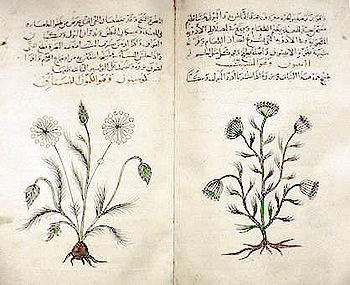Translation of herbals

During the Middle Ages, the study of plants began to be based on critical observations. "In the 16th and 17th century an interest in botany revived in Europe and spread to America by way of European conquest and colonization." Philosophers started to act as herbalists and academic professors studied plants with great depth. Herbalists began to explore the use of plants for both medicinal purposes and agricultural uses. Botanists in the Middle Ages were known as herbalists; they collected, grew, dried, stored, and sketched plants. Many became experts in identifying and describing plants according to their morphology and habitats, as well as their usefulness. These books, called herbals included beautiful drawings and paintings of plants as well as their uses.
At that time both botany and the art of gardening stressed the utility of plants for man; the popular herbal, described the medical uses of plants. During the Middle Ages, there was an expansion of book culture that spread through the medieval world. The phenomenon of translation is well-documented, from its beginnings as a scholarly endeavor in Baghdad as early as the eighth century to its expansion throughout European Mediterranean centers of scholarship by the eleventh and twelfth centuries. The process of translation is collaborative effort, requiring a variety of people to translate and add to them. However, how the Middle Ages viewed nature seems to be a mystery.
Translation of text and image has provided numerous versions and compilations of individual manuscripts from diverse sources, old and new. Translation is a dynamic process as well as a scholarly endeavor that contributed great to science in the Middle Ages; the process naturally entailed continuous revisions and additions. The Benedictine monasteries were known for their in-depth knowledge of herbals. These gardens grew the herbs which were considered to be useful for the treatment of the various human ills; the beginnings of modern medical education can be connected with monastic influence. Monastic academies were developed and monks were taught how to translate Greek manuscripts into Latin.
Knowledge of medieval botanicals was closely related to medicine because the plant's principal use was for remedies. Herbals were structured by the names of the plants, identifying features, medicinal parts of plant, therapeutic properties, and some included instructions on how to prepare and use them. For medical use of herbals to be effective, a manual was developed. Dioscorides' De material medica was a significant herbal designed for practical purposes.
Theophrastus wrote more than 200 papers describing the characteristics of over 500 plants. He developed a classification system for plants based on their morphology such as their form and structure. He described in detail pepper, cinnamon, bananas, asparagus, and cotton. Two of his best-known works, Enquiry into Plants and The Causes of Plants, have survived for many centuries and were translated into Latin. He has been referred to as the "grandfather of botany". Crateuas was the first to produce a pharmacological book for medicinal plants, and his book influenced medicine for many centuries. A Greek physician, Pedanius Dioscorides described over 600 different kinds of plants and describes their useful qualities for herbal medicine, and his illustrations were used for pharmacology and medicine as late as the Renaissance years.
Monasteries established themselves as centers for medical care. Information on these herbals and how to use them was passed on from monks to monks, as well as their patients. These illustrations were of no use to everyday individuals; they were intended to be complex and for people with prior knowledge and understanding of herbal. The usefulness of these herbals have been questioned because they appear to be unrealistic and several plants are depicted claiming to cure the same condition, as “the modern world does not like such impression." When used by experienced healers, these plants can provide their many uses. For these medieval healers, no direction was needed their background allowed them to choose proper plants to use for a variety of medical conditions. The monk's purpose was to collect and organize text to make them useful in their monasteries. Medieval monks took many remedies from classical works and adapted them to their own needs as well as local needs. This may be why none of the collections of remedies we have presently agrees fully with another.
Another form of translation was oral transmission; this was used to pass medical knowledge from generation to generation. A common misconception is that one can know early medieval medicine simply by identifying texts, but it is difficult to compose a clear understanding of herbals without prior knowledge.page needed There are many factors that played in influenced in the translation of these herbals, the act of writing or illustrating was just a small piece of the puzzle, these remedies stems from many previous translations the incorporated knowledge from a variety of influences.
Comments
Post a Comment